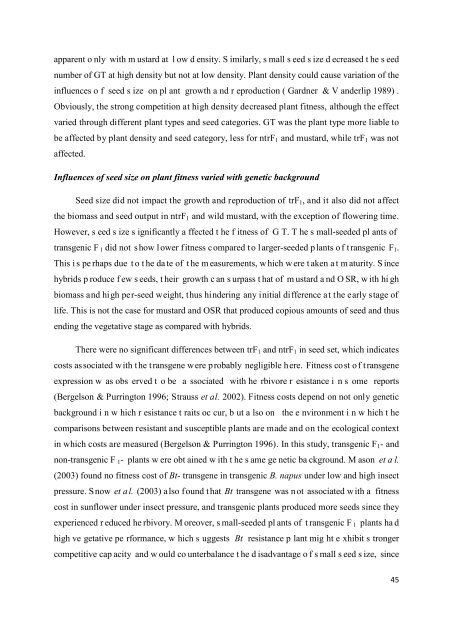UNIVERSITE DE BOURGOGNE THÈSE Yongbo LIU - Université de ...
UNIVERSITE DE BOURGOGNE THÈSE Yongbo LIU - Université de ...
UNIVERSITE DE BOURGOGNE THÈSE Yongbo LIU - Université de ...
Create successful ePaper yourself
Turn your PDF publications into a flip-book with our unique Google optimized e-Paper software.
apparent o nly with m ustard at l ow d ensity. S imilarly, s mall s eed s ize d ecreased t he s eed<br />
number of GT at high <strong>de</strong>nsity but not at low <strong>de</strong>nsity. Plant <strong>de</strong>nsity could cause variation of the<br />
influences o f seed s ize on pl ant growth a nd r eproduction ( Gardner & V an<strong>de</strong>rlip 1989) .<br />
Obviously, the strong competition at high <strong>de</strong>nsity <strong>de</strong>creased plant fitness, although the effect<br />
varied through different plant types and seed categories. GT was the plant type more liable to<br />
be affected by plant <strong>de</strong>nsity and seed category, less for ntrF1 and mustard, while trF1 was not<br />
affected.<br />
Influences of seed size on plant fitness varied with genetic background<br />
Seed size did not impact the growth and reproduction of trF1, and it also did not affect<br />
the biomass and seed output in ntrF1 and wild mustard, with the exception of flowering time.<br />
However, s eed s ize s ignificantly a ffected t he f itness of G T. T he s mall-see<strong>de</strong>d pl ants of<br />
transgenic F 1 did not show lower fitness compared to larger-see<strong>de</strong>d p lants o f t ransgenic F1.<br />
This i s pe rhaps due t o t he da te of t he m easurements, w hich w ere t aken a t m aturity. S ince<br />
hybrids p roduce f ew s eeds, t heir growth c an s urpass t hat of m ustard a nd O SR, w ith hi gh<br />
biomass and high per-seed weight, thus hin<strong>de</strong>ring any initial difference at the early stage of<br />
life. This is not the case for mustard and OSR that produced copious amounts of seed and thus<br />
ending the vegetative stage as compared with hybrids.<br />
There were no significant differences between trF1 and ntrF1 in seed set, which indicates<br />
costs associated with the transgene were probably negligible here. Fitness cost of transgene<br />
expression w as obs erved t o be a ssociated with he rbivore r esistance i n s ome reports<br />
(Bergelson & Purrington 1996; Strauss et al. 2002). Fitness costs <strong>de</strong>pend on not only genetic<br />
background i n w hich r esistance t raits oc cur, b ut a lso on the e nvironment i n w hich t he<br />
comparisons between resistant and susceptible plants are ma<strong>de</strong> and on the ecological context<br />
in which costs are measured (Bergelson & Purrington 1996). In this study, transgenic F1- and<br />
non-transgenic F 1- plants w ere obt ained w ith t he s ame ge netic ba ckground. M ason et a l.<br />
(2003) found no fitness cost of Bt- transgene in transgenic B. napus un<strong>de</strong>r low and high insect<br />
pressure. Snow et al. (2003) also found that Bt transgene was n ot associated with a fitness<br />
cost in sunflower un<strong>de</strong>r insect pressure, and transgenic plants produced more seeds since they<br />
experienced r educed he rbivory. M oreover, s mall-see<strong>de</strong>d pl ants of t ransgenic F 1 plants ha d<br />
high ve getative pe rformance, w hich s uggests Bt resistance p lant mig ht e xhibit s tronger<br />
competitive cap acity and w ould co unterbalance t he d isadvantage o f s mall s eed s ize, since<br />
45
















